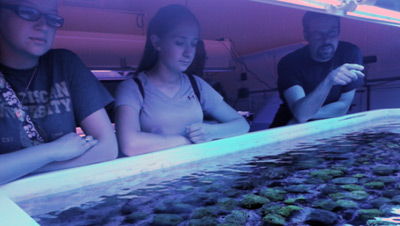September may be a long way from Christmas, but for reefkeepers, it’s the next best thing. September is the unofficial kickoff of the coral fragment swap season. Soon the eyes and hearts of reefkeepers everywhere will turn to swapper pages and message boards, searching for that special piece that the keeper just can’t live without. But before we blow our children’s college fund on new coral this fall, let’s make sure we are fully prepared to give those new pieces the best chance to thrive in our systems.
First things first
Discussion should start with the question: “Where are we going to put this piece?” That question should be followed by the equally important: “Does that spot give the coral the proper lighting and water flow?” Another consideration is whether the coral will get along with its new neighbors.
Many corals use some sort of sweeping tentacles to keep space for themselves. Left unchecked, stings from these sweepers can result in coral death. Most corals will respond fine to being trimmed to keep their place in the system. This is especially true of stony corals, yet some soft corals will not respond as well, and that must be taken into consideration before purchase.
The right coral for the right spot—let’s go get it!
Not so fast, buster! Are you really willing to risk the health of your reef tank to add a piece from a system you may know little or nothing about? Pests come in so many forms that it would take a week to list them all. Coral keeping pros, such as Todd from Cherry Corals in Michigan, recommend a two-step process to ensure the safety of your system.
Keeping it safe
Step one is a dipping treatment for the coral fragment. The pros use their own formulas of insecticides, but regular folks like us will be well served by buying an over-the-counter product (such as Coral Rx). The nice thing about this option is that the dips come premixed and ready to use. Cherry Corals recommends dipping coral fragments according to the directions on the bottle, including both the time of exposure and rinsing afterwards.
The second step is to quarantine those new fragments from your system for two to four more weeks after the dipping. Far too many reefkeepers skip this phase and often pay a heavy price when a pest sneaks past the dipping procedure. Just like isolating a new fish, your new corals should not be in contact with the water of your display system. If you are very patient, you could even let your fragment grow enough to be split in two, giving you a display piece and a very clean piece to trade to someone else.
So, some time before the coral swap meet, we need to buy coral dip and set up a quarantine tank complete with the right lighting. It would not hurt to also have some super glue gel on hand in the event that the fragment pops off the plug it came to you on.
Ready, set, go!
The prep work is done, and the day of the big show is at hand. So our thoughts have to turn to how we are going to get those new gems home. A hand-held cooler is a good choice. Pick one big enough to accommodate all your new pieces, but small enough to fit through the crowded aisles of fellow traders. A towel or two will be handy as packing material to keep the containers upright and leak free.
We also need to be aware of the temperature forecast for that day. Too warm and we will need a cold pack; too cool and we will have to go with hand warmers. The towels will also double as insulators, keeping the packs from directly touching the fragment containers.
Parting thoughts
We did a good job of prepping, selecting corals that will thrive in our system, and getting them home safely. Now the only job left is to grab some good pics of the corals in their new home and brag to all our reefkeeping friends. Good luck and happy swapping!
Photo credit: Dave Bowers



